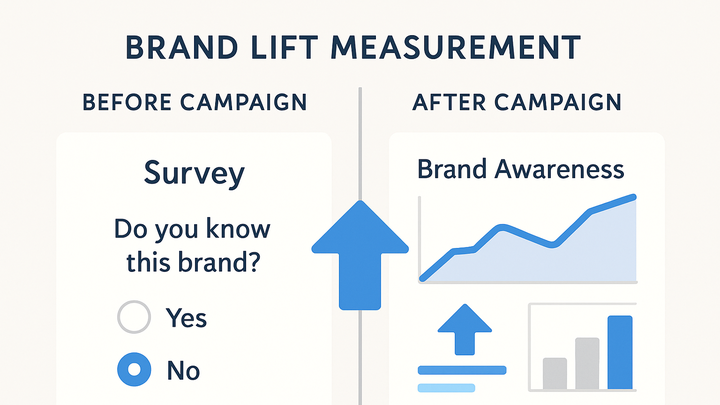Published on 2025-06-22T06:47:59Z
What Is Brand Lift? Definition, Importance, and Examples
Brand Lift is a metric used in analytics to measure the change in consumer perception, awareness, and intent following a marketing or advertising campaign. It goes beyond click-based and conversion metrics to capture the intangible value of brand equity growth. Brand Lift studies typically compare a control group (unexposed) with a test group (exposed) to quantify shifts in key indicators like awareness, ad recall, consideration, and purchase intent. In Google Analytics 4 (GA4), Brand Lift integrates with Google Ads to automate survey distribution and real-time reporting, while cookie-free platforms like PlainSignal can approximate Brand Lift through behavioral signals such as spikes in direct traffic and branded search volume. By understanding Brand Lift, marketers can validate campaign effectiveness, optimize creative messaging, and allocate budgets to maximize long-term brand health.
Brand lift
Brand Lift measures changes in consumer perception post-campaign using surveys and analytics to gauge brand awareness and consideration.
Understanding Brand Lift
Brand Lift quantifies the shift in consumer perception, awareness, and intent resulting from your marketing efforts. It goes beyond click-based metrics to capture how audiences mentally respond to your brand after exposure to campaigns.
-
Definition
Brand Lift measures the percentage change in key brand metrics—such as awareness, consideration, recall, and purchase intent—by comparing exposed (test) groups with unexposed (control) groups.
-
Why it matters
By focusing on perception rather than direct conversions, Brand Lift provides insights into the long-term equity and health of your brand, helping justify marketing spend and guiding creative strategies.
Measurement Approaches
There are two primary methods for measuring Brand Lift: survey-based studies for qualitative insights and behavioral analytics for quantitative approximations.
-
Survey-based studies
These involve polling control and test audiences with questions about brand awareness, ad recall, and purchase intent to quantify perception changes directly.
-
Behavioral analytics
This method uses web and app usage data—such as direct traffic spikes, branded search volume, and returning visitor ratios—to infer shifts in brand interest indirectly.
Measuring Brand Lift in GA4
Google Analytics 4 integrates with Google Ads to run Brand Lift studies, automating survey distribution and analysis within your analytics dashboard.
-
Setting up brand lift studies
Link your GA4 property with Google Ads, select your audience segments, define control and test groups, and configure survey questions directly in the Google Ads interface.
-
Link google ads account
In GA4 Admin settings, under Product Links, create a link to your Google Ads account to enable Brand Lift data sharing.
-
Define survey parameters
Choose metrics like ad recall or brand awareness, and set the survey cadence, audience targeting, and sample size thresholds.
-
-
Analyzing GA4 brand lift reports
Access the Brand Lift report in GA4 to view percentage lift for each question, compare baseline vs. exposed metrics, and segment results by demographics or campaign.
Tracking Brand Lift with PlainSignal
PlainSignal, a cookie-free analytics tool, allows you to approximate Brand Lift by monitoring key behavioral indicators on your website.
-
Implementing PlainSignal tracking
Add the following snippet to your HTML to start capturing visitor interactions without cookies:
-
Tracking snippet
<link rel="preconnect" href="//eu.plainsignal.com/" crossorigin /> <script defer data-do="yourwebsitedomain.com" data-id="0GQV1xmtzQQ" data-api="//eu.plainsignal.com" src="//cdn.plainsignal.com/plainsignal-min.js"></script>
-
-
Key metrics to monitor
Monitor the following indicators to gauge Brand Lift with PlainSignal analytics:
-
Direct traffic growth
An increase in direct visits may signal heightened brand recall post-campaign.
-
Branded search volume
Track referrals from search queries containing your brand name to assess awareness spikes.
-
Returning visitor rate
A higher ratio of repeat visitors can indicate improved brand consideration and loyalty.
-
Best Practices and Considerations
Ensure your Brand Lift measurement is robust, statistically sound, and aligned with your business goals.
-
Ensure statistical significance
Use sufficiently large sample sizes and run tests long enough to achieve reliable results, minimizing random variance.
-
Control external influences
Account for seasonality, competing campaigns, and market trends that could skew perception metrics independently of your efforts.
-
Maintain privacy compliance
When conducting surveys or tracking user behavior, adhere to GDPR, CCPA, and other privacy regulations to protect user data.
